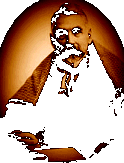Stephane Mallarme
(1842-1898)

Great French Symbolist poet
Stephane Mallarme was born in Paris in 1842. He began writing poetry at an early age under
the influence of Charles Baudelaire. His first poems
started to appear in magazines in the 1860s.
The work of the Stephane Mallarme
has often been considered the best example of "pure poetry." Mallarme dealt in
metaphorical obliquities and attempted to practice alchemy with words — to create a
kind of poetry where the word as symbol would have a new mobility and would achieve new
intensities and refinements of meaning.
Mallarme's most well known poems are
L'Apres Midi D'un Faun (The Afternoon of a Faun) (1865), which
inspired Debussy's tone poem (1894) of the same name and was illustrated by Manet. Among
his other works are Herodiade (1896) and Toast Funebre (A Funeral Toast), which was
written in memory of the author Theopile Gautier. Mallarme's later works include the
experimental poem Un Coup de Des (1914), published posthumously.
From the 1880s Mallarme was the center of
a group of french writers in Paris, including Andre Gide and Paul Valery, to whom he
communicated his ideas on poetry and art. According to his theories, nothing lies beyond
reality, but within this nothingness lies the essence of perfect forms and it is the task
of the poet to reveal and crystallize these essences. Mallarme's poetry employs condensed
figures and unorthodox syntax. Each poem is build around a central symbol, idea, or
metaphor and consists on subordinate images that illustrate and help to develop the idea.
Mallarme's vers libre and word music shaped the 1890s Decadent movement.
Debussy's tone poem The Afternoon of a
Faun, and the ballet immortalized by Nijinski, are based on a famous poem of Mallarme ,
while the visual pattern of his poem A Throw of the Dice Will Never Abolish Chance
foreshadowed the typographical experimentation of contemporary poetry. Certain of
Mallarme's aesthetic theories parallel those of the abstract painters of today, while his
poetical syntax can be compared to the technique of the Cubists.
For the rest of his life Mallarme devoted
himself to putting his literary theories into practice and writing his Grand Oeuvre (Great
Work). Mallarme died in Paris on September 9, 1898 without completing this work.

